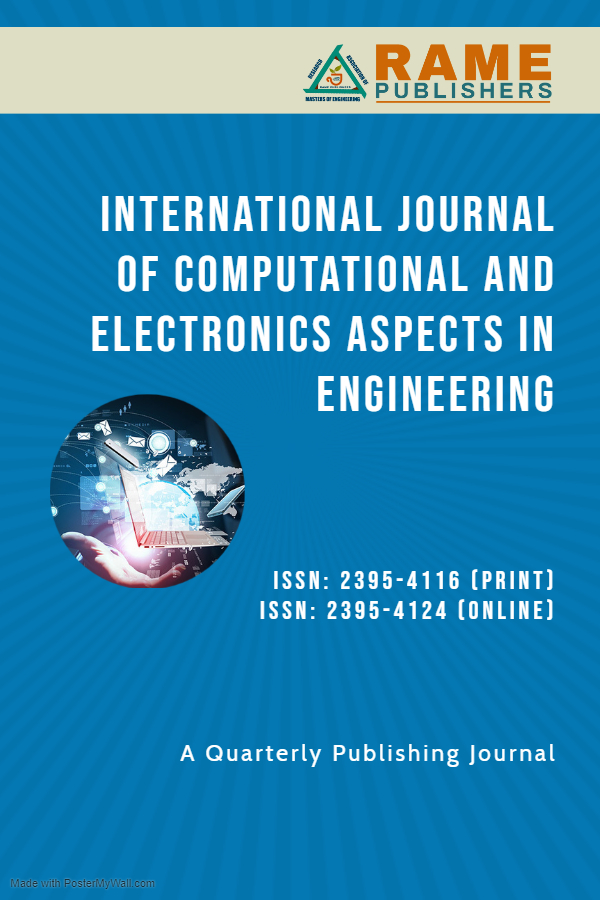Optimized Energy-Efficient Cluster Routing in IoT-Enabled Wireless Sensor Networks via Mapdiminution-Based Training and Discovery Algorithm
Alaa A. Hussain, Muthana Naser hussein, Zainab Fahad Alnaseri
International Journal of Computational and Electronic Aspects in Engineering
Volume 6: Issue
2, May 2025, pp 70-80
Author's Information
Alaa A. Hussain 1
Corresponding Author
1College of Management and Economics, Sumer University, Rifai, Iraq
Alaa91hussain@gmail.com
Muthana Naser Hussein2
2Ministry of Education, Dhi Qar Education Directorate, Iraq
Zainab Fahad Alnaseri3
3College of computer science and information Technology, University of AL-Qadisiyah, Iraq
Abstract:-
The combination of WSNs and IoT technologies produces rapid mass-production yet requires energy-efficient routing protocols to fulfill the estimated demands. These protocols need further development to maintain continuous sensor node connections during their operational periods. The design of WSNs encounters a significant problem because sensor nodes have limited energy capabilities. The placement of NSN in specific zones creates difficulties for standard battery replacement and maintenance operations. Network routing for these systems needs energy preservation as their fundamental construction requirement. This paper proposes a Mapdiminution-Based Training-Discovering Optimization Algorithm (MTDOA), a new protocol that aims at increasing energy efficiency for IoT based WSNs. The MTDOA protocol is based on a novel mapdiminution-based dimensionality reduction and a mixed metaheuristic optimization method. This model is intended to allow for a good trade-off between, global and local search during the optimization process in aspects such as selection of efficient heads of clusters and identification of energy optimal routing paths. Thus, these components are therefore combined in the algorithm to cut down on computational cost, ensure faster convergence time and overall lifespan of the sensor network. The MTDOA protocol uses dynamic adaptive training discovery to select cluster heads from nodes based on their energy levels to reduce base station data routing costs. Simulation experiments run in the laboratory showed MTDOA performs better than LEACH and DEEC protocols when measuring network lifetime and average residual energy together with packet delivery ratio. MTDOA methodology enables successful sustainability improvements in WSN networks through its combination of better IoT-based metrics and performance metrics.Index Terms:-
Wireless Sensor Networks (WSNs), Internet of Things (IoT), Energy Efficiency, Cluster-Based Routing, Metaheuristic Optimization, Mapdiminution, Training-Discovering Algorithm, Network Lifetime, Residual Energy, Packet Delivery Ratio.REFERENCES
- W. B. Heinzelman, A. Chandrakasan, and H. Balakrishnan, “Energy-efficient communication protocol for wireless
microsensor networks,” 2000.
- J. Kennedy and R. Eberhart, “Particle swarm optimization,” 1995.
- J. H. Holland, Adaptation in Natural and Artificial Systems, 1992.
- X.-S. Yang, Nature-Inspired Metaheuristic Algorithms, 2010.
- S. Mishra and D. Pandey, “A review on energy-efficient clustering in wireless sensor networks using metaheuristic
algorithms,” 2020.
- Y. Xu, J. Li, and L. Shu, “Energy-efficient WSNs for industrial applications,” 2015.
- N. A. Pantazis, S. A. Nikolidakis, and D. D. Vergados, “Energy-efficient routing protocols in wireless sensor
networks: A survey,” 2013.
- A. A. Abbasi and M. Younis, “A survey on clustering algorithms for wireless sensor networks,” 2007.
- S. Singh, P. K. Sharma, and J. H. Park, “A survey on energy-efficient sensor node placement algorithms,” 2017.
- M. B. Yassein, A. Al-zou'bi, Y. Khamayseh, and W. Mardini, “Improvement on LEACH protocol of wireless sensor
network (VLEACH),” 2014.
- N. A. Latiff, C. C. Tsimenidis, and B. S. Sharif, “Energy-aware clustering for wireless sensor networks using
particle swarm optimization,” 2007.
- S. Rani, R. Talwar, and J. Malhotra, “A comparative study of PSO and GA optimization for WSN clustering,” 2015.
- X. Wang, J. Ma, S. Wang, and D. Bi, “Distributed energy-efficient clustering algorithm for ad hoc sensor networks,”
2007.
- H. Wang, Y. Zhang, and Y. Xu, “Deep learning-based energy-efficient WSN clustering,” 2021.
- A. Ghosh and S. Das, “Coverage and connectivity issues in wireless sensor networks: A survey,” 2008.
- T. Banerjee and S. Misra, “Fault-tolerant WSN clustering: A bio-inspired approach,” 2013.
- S. Ehsan and B. Hamdaoui, “A survey on energy-efficient routing techniques in wireless sensor networks,” 2012.
- X. Liu, “A survey on clustering routing protocols in wireless sensor networks,” 2012.
- A. Alshahrani and M. Al-Mulhem, “Efficient clustering in WSN using hybrid optimization,” 2019.
- S. S. Yadav and R. Chauhan, “Energy-efficient routing protocols using nature-inspired algorithms in WSN,” 2020.
- A. A. Hussain, B. Abood, and K. M. Hashim, “Lifetime enhancement to improve data transmitted for clustering
protocol in heterogeneous wireless sensor networks,” IOP Conf. Ser.: Mater. Sci. Eng., vol. 928, 032040, 2020.
https://doi.org/10.1088/1757-899X/928/3/032040
- A. A. Hussain, “A static clustering strategy for reducing energy consumption in a wireless sensor network,” 2nd
Conf. Pure and Medical Sciences, Mathematics and Statistics, vol. 1, no. 1, Nov. 2022.
- M. H. Geem and A. M. Abbood, “On α-g-transformation and its properties,” AIP Conf. Proc., vol. 2834, no. 1, 2023.
https://doi.org/10.1063/5.0165995
- M. H. Geem, “On strongly continuous ρh-semigroup,” J. Phys.: Conf. Ser., vol. 1234, no. 1, 2019.
https://doi.org/10.1088/1742-6596/1234/1/012109
- M. H. Geem, A. R. Hassan, and H. I. Neamah, “0-Semigroup of g-transformation,” J. Interdiscip. Math., vol. 28, no.
1, pp. 311–316, 2025.
- https://bmcbioinformatics.biomedcentral.com/articles/10.1186/s12859-023-05619-z
- S. H. Mohammad, I. Z. C. Alrikabi, and H. R. D. Al-Fayyadh, “Number plate recognition system based on an improved
segmentation method,” Int. J. Comput. Electron. Asp. Eng., vol. 6, no. 1, pp. 42–50, 2025.
https://doi.org/10.26706/ijceae.6.1.20250207
- S. I. Hamad, “Utilizing convolutional neural networks for the identification of lung cancer,” Int. J. Comput.
Electron. Asp. Eng., vol. 6, no. 1, pp. 35–41, 2025. https://doi.org/10.26706/ijceae.6.1.20250206
- H. Hatem, “Improved deep learning models for plant diseases detection for smart farming,” Int. J. Comput. Electron.
Asp. Eng., vol. 6, no. 1, pp. 10–21, 2025. https://doi.org/10.26706/ijceae.6.1.20250204
To view full paper, Download here
To View Full Paper
For authors
Author's guidelines Publication Ethics Publication Policies Artical Processing Charges Call for paper Frequently Asked Questions(FAQS) View All Volumes and IssuesPublishing with




